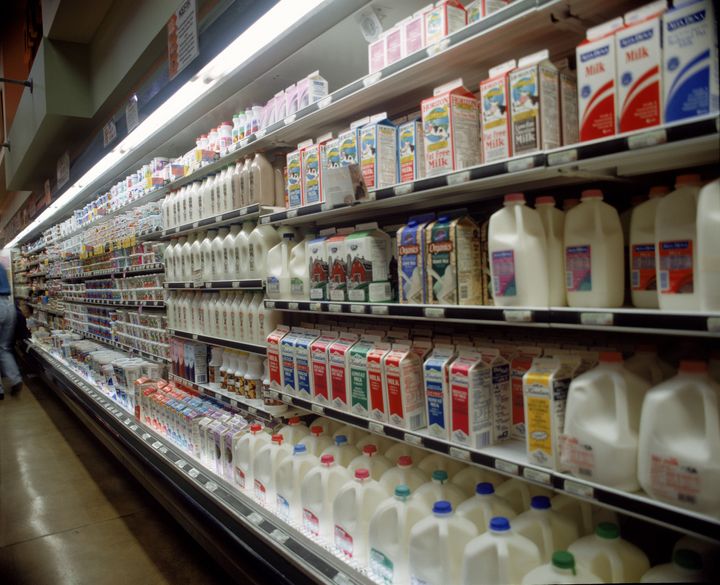They claim it has more nutrients and fewer chemicals, but food safety experts have their own thoughts.
By now, most of us know that ultra-processed foods aren’t so great for us, and that a diet rich in whole foods is correlated with improved heart health. But can an emphasis on foods in their purest form ever be taken too far?
Absolutely, as evidenced by the latest TikTok trend: drinking raw milk. As in, raw milk straight from the cow that hasn’t been pasteurized.
While you’ll find a wide variety of opinions surrounding raw milk, it’s easy to find TikTokers who swear by it for health reasons — they say it has more nutrients and fewer chemicals, it’s easier to digest, the list goes on. If you’re considering adding raw, unpasteurized cow’s milk to your diet (which may require some travel, as raw milk is not legal in every state), read this first.
Does raw milk actually contain more nutrients than pasteurized milk?
Maybe, but the benefits don’t outweigh the risks.
“Raw milk contains natural vitamins and minerals. Some studies suggest that pasteurization can reduce the levels of certain heat-sensitive vitamins like vitamins C and B,” explained Zachary Cartwright, lead food scientist at Aqualab. “However, milk is not a significant source of these vitamins, so the overall nutritional impact may be minimal.”
Registered dietitian Maggie Michalczyk agreed.
“Raw milk may contain more amino acids, antimicrobials, vitamins and minerals and fatty acids than pasteurized milk, however, more evidence is needed to support these claims,” she said. “While there may be some nutritional benefits to drinking raw milk, it’s not something I’m currently recommending people go out of their way to consume.” Because raw milk can allow harmful bacteria to grow, Michalczyk emphasized that people who are pregnant, children, older adults and those with weakened immune systems should use caution and avoid drinking it.
According to Sam Martin, senior director and food safety expert at Microbac Laboratories, contrary to popular belief (at least on TikTok), the pasteurization process doesn’t significantly alter the nutritional value of milk.
“According to several scientific studies, the protein and fat levels in pasteurized milk are essentially the same as those in raw milk,” he said. “The mineral content is virtually unchanged because minerals are stable at pasteurization temperatures. There is a slight reduction in vitamin C content, but milk is not a significant source of vitamin C in the first place.”
He also added that if you have a food allergy, lactose intolerance or issues with digesting milk, raw milk won’t make a difference.
Raw Milk And Food Safety
You’ve probably seen a lot of headlines about listeria outbreaks in recent weeks. If these are concerning to you at all, trust us (and the experts we spoke with) on this one: Drinking raw milk is probably more dangerous than consuming deli meat. “Raw milk can harbor dangerous microorganisms like campylobacter, e. coli, listeria, salmonella and several others that cause food poisoning,” Martin said. “It can also be a source of mycobacterium tuberculosis and m. bovis, which is what causes tuberculosis and bovine tuberculosis.”

As Michalczyk mentioned, those with weakened immune systems are especially at risk for getting food poisoning from raw milk, and the consequences can be dire. As in, it could involve more than spending a day or two on the toilet. “E. coli O157:H7 [which can be found in raw milk] can lead to hemolytic uremic syndrome (HUS), which can cause kidney failure and lead to death,” Martin said.
Cartwright emphasizes that consuming raw milk will always carry some risk of foodborne illness, but if you really want to drink it for whatever reason, precautions can be taken to make it a little safer. “Risks can be minimized by ensuring the raw milk comes from a reputable source with stringent hygiene and health standards and the raw milk is refrigerated at all times prior to consumption and consumed before its expiration date,” he said.
State Laws And The Pasteurization Process
If raw milk is so dangerous, why is it legal in some states? “The Grade A Pasteurized Milk Ordinance (PMO) was established by the FDA and defines the processes and procedures necessary to produce safe milk,” Martin explained. “However, the FDA’s jurisdiction is limited to interstate commerce, opening the door for states to allow the sale of raw milk within their own borders — usually with strict labeling requirements.”
We know the pasteurization process doesn’t significantly strip milk of its nutrients, but what does it actually entail?
According to Martin, there are three different pasteurization processes used in milk production, and all of them destroy harmful bacteria and make milk last longer. The first is batch pasteurization. “This involves heating the milk to at least 145°F and holding it for at least 30 minutes before cooling to less than 40°F,” Martin said.
The second is High Temperature Short Time (HTST) pasteurization, which is also the most common pasteurization process in the U.S. Martin explained that HTST pasteurization requires milk to be heated to at least 161°F and held for at least 15 seconds before cooling to less than 40°F. Finally, Higher Heat Shorter Time (HHST) pasteurization is when the milk is heated to at least 191°F and held for at least 1 second before cooling.
Regardless of the pasteurization process used, Martin emphasizes, you’ll still end up with safe, nutrient-dense milk. So while it may be tempting to give in to the raw milk fad based on what you see on social media, both food safety experts and nutritionists are begging you not to. Pure it may be, but it’s just not worth risking your safety for.
Credit: Source link